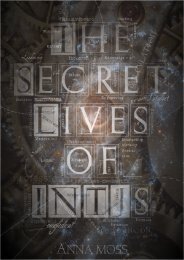Create successful ePaper yourself
Turn your PDF publications into a flip-book with our unique Google optimized e-Paper software.
comparisons. In fact, I would go so far as to say that I.Q. tests do not even constitute valid data on<br />
intelligence for most non-INs, though there are ENP types that also score very highly.<br />
You're probably curious as to where INTJs fall in the I.Q. ranking. Three out of four factors are in<br />
their favor, so they should be one of the highest ranked types.<br />
Three I.Q. studies have placed INTJs at 1 st , 2 nd , and tied for 3 rd place in terms of being the highest<br />
scoring type. 194 This is close to what we would expect based on our hypothesis above—a nearly<br />
top-ranked score. The amount of variability is normal.<br />
Laying aside I.Q. tests, let's examine aptitude tests, which include I.Q. tests as well as the SAT,<br />
ACT, etc. A survey of studies found that INTJs are the type that scores most highly on aptitude<br />
tests, followed by the INTPs. 195<br />
Remember that no two INTJs are alike in terms of either type, ability or intelligence. The<br />
discussion above is of averages and generalities; you may be above or below average compared to<br />
the rest of your type.<br />
Giftedness<br />
Intelligence is one thing, giftedness is another. It is true that all types have their own unique gifts to<br />
offer, but some gifts are rarer than others and the laws of economics push the value of those gifts<br />
up. Gifted programs serve primarily certain types whose scientific and poetic contributions to the<br />
human race are particularly prized. The contributions of other intelligent types are appreciated<br />
through other programs, though such programs are not associated with a label that actually denotes<br />
intelligence.<br />
Sak (2004) did a “study of studies” in which he agglomerated the results of 14 separate studies on<br />
type and giftedness and analyzed the combined sample of 5,723 gifted 6 th - 12 th graders. The results<br />
showed a trend towards NP, with 50% of the sample consisting of INFPs, INTPs, ENFPs, and<br />
ENTPs. Indeed, ~60% of the gifted sample was perceiving, while ~70% was intuitive. The sample<br />
was also more introverted and thinking than would be expected in comparison to a normal group of<br />
high schoolers. Despite the slight predominance of perceivers, INTJs nevertheless ranked highly.<br />
As can be seen in the chart below, the most important factor in being considered for the gifted label<br />
is IN, then T, then P.<br />
The representation of types within the combined gifted sample was as follows:<br />
INTP 3.53 times as many as would be expected.<br />
INTJ 2.87 "<br />
INFP 2.68<br />
INFJ 2.67<br />
ENTP 2.32<br />
ENFP 2.03<br />
ENTJ 1.49<br />
ENFJ 1.26<br />
ISTJ 0.98<br />
ISTP 0.78<br />
ESFP 0.60<br />
ISFP 0.39<br />
194 McCaulley & Kainz; McCaulley & Natter; Myers & McCaulley in Myers, McCaulley, Quenk & Hammer, 1998<br />
195 Myers, McCaulley, Quenk & Hammer, 1998




